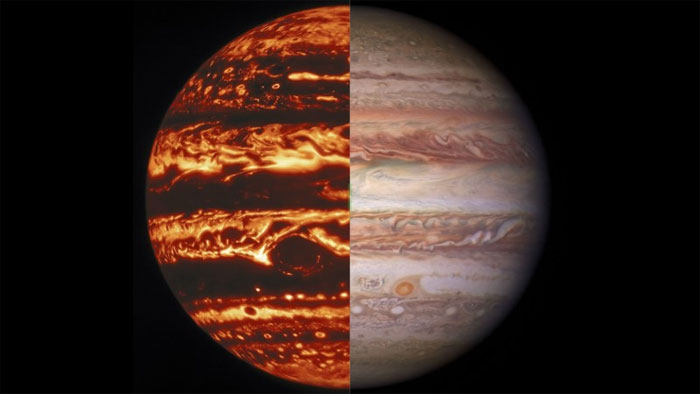Spacecraft reveals mystery of Jupiter's atmosphere
The Juno space probe is exploring deeper into Jupiter's clouds. So far, Juno has provided new information about how water behaves in the clouds at Jupiter.
The spacecraft also said that the cause of tornadoes at the poles appears to be stable.
Juno uses gravity techniques to explore the extent of the rings and atmospheres at the giant planet. This makes it possible to detect thousands of miles or kilometers below the cloud tops. In addition, measuring the magnetic field is also effective.

Juno has been in Jupiter's orbit since 2016.
Because, in the lower part of Jupiter's gaseous crust, hydrogen behaves more like a liquid than a gas. This phenomenon affects the activity of the atmosphere.
In addition, the microwave radiometer has shown a strange reversal in a large storm at Jupiter - where the temperature suddenly changes from warm to cold.
Juno Principal Investigator Scott Bolton said: 'What we're seeing is the 'root' of the storm going through clouds and sunlight.
This phenomenon is different from Earth, where the atmosphere is affected by water, condensation and sunlight. It is also a sign that ammonia and water are moving up and down , Bolton said .
"These new observations from Juno open up a treasure trove of new information about the mysterious observed features of Jupiter," said Lori Glaze, director of NASA's Planetary Science Division at the agency's headquarters in Washington. . Each paper sheds light on different aspects of planetary atmospheric processes. This is a great example of how our internationally diverse scientific groups strengthen our understanding of our Solar System'.
Juno has been in Jupiter's orbit since 2016. Each time the spacecraft passes by the planet, a specialized instrumentation has peered beneath its turbulent cloud cover.
The temperature of Jupiter's atmosphere is just right for the formation of a water cloud about 65km from the top of the cloud. While peering through this layer, the Juno probe made a surprising discovery. The belts become microwaved dark and the regions become microwave bright.
This is the exact opposite of what we have seen in the shallower cloud regions. This is called the 'jovicline' transition layer - about 45 - 80km below the visible clouds.
'Cline' is a liquid inner layer where properties change dramatically. Earth's oceans have a heat path that divides the mixture of water on the surface from the cold and deep water below. The jovicline can separate the shallow cloud-forming weather layer from the abyss below. This unexpected result implies that something is moving the ammonia around.
- Try the artificial meteorite successfully
- New discovery about Pluto's atmosphere
- NASA's $ 3.3 billion spacecraft is about to commit suicide on Saturn
- A series of monstrous planets with clouds ... aluminum and titanium rain
- The UAE is about to launch a spacecraft to Mars
- America will risk the sun
- NASA launches the spacecraft to explore the Moon's atmosphere
- LADEE spacecraft flew into Moon's orbit
- NASA returned to the moon
- Discover the super typhoon mystery that appears on Saturn
- America is about to launch a ship to Mars
- NASA ships detected this anomaly near Earth's atmosphere
 Van Allen's belt and evidence that the Apollo 11 mission to the Moon was myth
Van Allen's belt and evidence that the Apollo 11 mission to the Moon was myth The levels of civilization in the universe (Kardashev scale)
The levels of civilization in the universe (Kardashev scale) Today Mars, the sun and the Earth are aligned
Today Mars, the sun and the Earth are aligned The Amazon owner announced a secret plan to build a space base for thousands of people
The Amazon owner announced a secret plan to build a space base for thousands of people